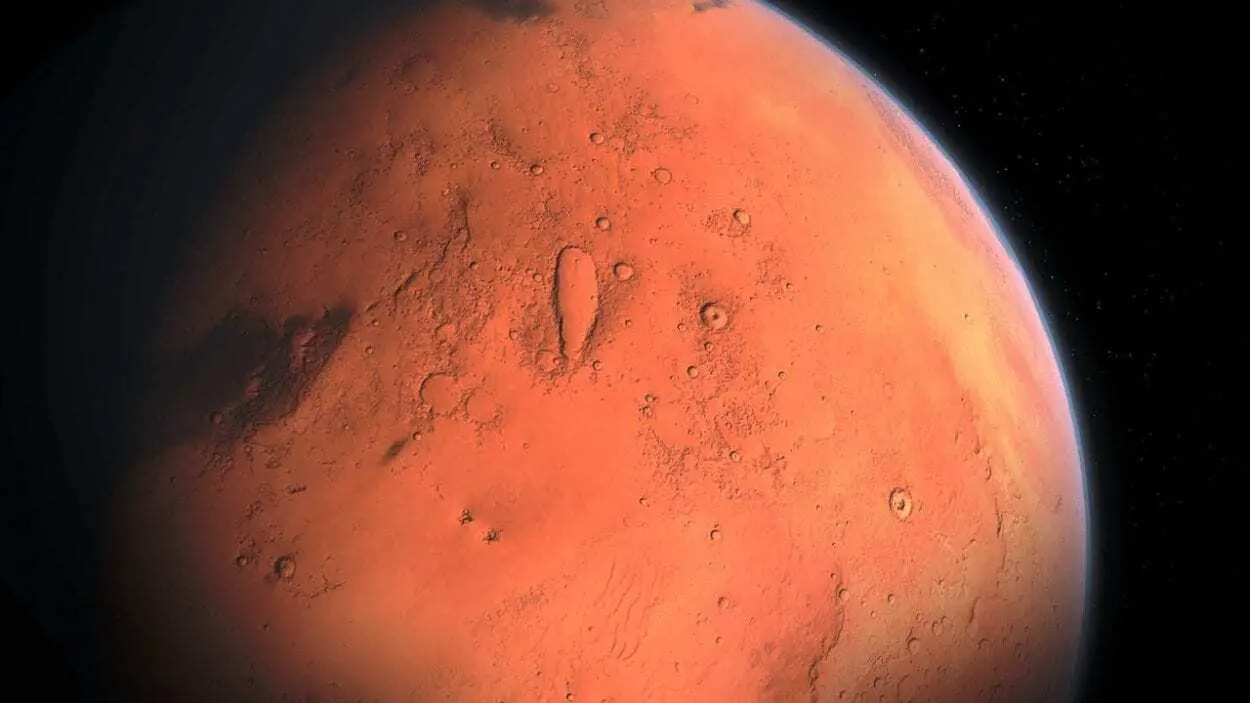In Jessica Barnes’ palm is an ancient, coin-sized mosaic of glass, minerals and rocks as thick as a strand of wool fiber.
It is a slice of Martian meteorite, known as Northwest Africa 7034 or Black Beauty, that was formed when a huge impact cemented together various pieces of Martian crust.
Barnes is an assistant professor of planetary sciences in the University of Arizona Lunar and Planetary Laboratory. She and her team chemically analyzed the Black Beauty meteorite and the infamous Allan Hills 84001 meteorite – controversial in the 1990s for allegedly containing Martian microbes – to reconstruct Mars’ water history and planetary origins.
Their analysis, published today in Nature Geoscience, showed that Mars likely received water from at least two vastly different sources early in its history. The variability the researchers found implies that Mars, unlike Earth and the moon, never had an ocean of magma completely encompassing the planet.
“These two different sources of water in Mars’ interior might be telling us something about the kinds of objects that were available to coalesce into the inner, rocky planets,” Barnes said. Two distinct planetesimals with vastly different water contents could have collided and never fully mixed. “This context is also important for understanding the past habitability and astrobiology of Mars.”
Reading the Water
“A lot of people have been trying to figure out Mars’ water history,” Barnes said. “Like, where did water come from? How long was it in the crust (surface) of Mars? Where did Mars’ interior water come from? What can water tell us about how Mars formed and evolved?”
Barnes and her team were able to piece together Mars’ water history by looking for clues in two types, or isotopes, of hydrogen. One hydrogen isotope contains one proton in its nucleus; this is sometimes called “light hydrogen.” The other isotope is called deuterium, which contains a proton and a neutron in the nucleus; this is sometimes referred to as “heavy hydrogen.” The ratio of these two hydrogen isotopes signals to a planetary scientist the processes and possible origins of water in the rocks, minerals and glasses in which they’re found.
Meteorite Mystery
For about 20 years, researchers have been recording the isotopic ratios from Martian meteorites, and their data were all over the place. There seemed to be little trend, Barnes said.
Water locked in Earth rocks is what’s called unfractionated, meaning it doesn’t deviate much from the standard reference value of ocean water – a 1:6,420 ratio of heavy to light hydrogen. Mars’ atmosphere, on the other hand, is heavily fractionated – it is mostly populated by deuterium, or heavy hydrogen, likely because the solar wind stripped away the light hydrogen. Measurements from Martian meteorites – many of which were excavated from deep within Mars by impact events – ran the gamut between Earth and Mars’ atmosphere measurements.
Barnes’ team set out to investigate the hydrogen isotope composition of the Martian crust specifically by studying samples they knew were originated from the crust: the Black Beauty and Allan Hills meteorites. Black Beauty was especially helpful because it’s a mashup of surface material from many different points in Mars’ history.
“This allowed us to form an idea of what Mars’ crust looked like over several billions of years,” Barnes said.
The isotopic ratios of the meteorite samples fell about midway between the value for Earth rocks and Mars’ atmosphere. When the researchers’ findings were compared with previous studies, including results from the Curiosity Rover, it seems that this was the case for most of Mars’ 4 billion-plus-year history.
“We thought, ok this is interesting, but also kind of weird,” Barnes said. “How do we explain this dichotomy where the Martian atmosphere is being fractionated, but the crust is basically staying the same over geological time?”
Barnes and her colleagues also grappled with trying to explain why the crust seemed so different from the Martian mantle, the rock later which lies below.
“If you try and explain this fairly constant isotopic ratio of Mars’ crust, you really can’t use the atmosphere to do that,” Barnes said. “But we know how crusts are formed. They’re formed from molten material from the interior that solidifies on the surface.”
“The prevailing hypothesis before we started this work was that the interior of Mars was more Earthlike and unfractionated, and so the variability in hydrogen isotope ratios within Martian samples was due to either terrestrial contamination or atmospheric implantation as it made its way off Mars,” Barnes said.
The idea that Mars’ interior was Earthlike in composition came from one study of a Martian meteorite thought to have originated from the mantle – the interior between the planet’s core and its surface crust.
However, Barnes said, “Martian meteorites basically plot all over the place, and so trying to figure out what these samples are actually telling us about water in the mantle of Mars has historically been a challenge. The fact that our data for the crust was so different prompted us to go back through the scientific literature and scrutinize the data.”
The researchers found that two geochemically different types of Martian volcanic rocks -enriched shergottites and depleted shergottites – contain water with different hydrogen isotope ratios. Enriched shergottites contain more deuterium than the depleted shergottites, which are more Earth-like, they found.
“It turns out that if you mix different proportions of hydrogen from these two kinds of shergottites, you can get the crustal value,” Barnes said.
She and her colleagues think that the shergottites are recording the signatures of two different hydrogen – and by extension, water – reservoirs within Mars. The stark difference hints to them that more than one source might have contributed water to Mars and that Mars did not have a global magma ocean.
Header Image – Public Domain





